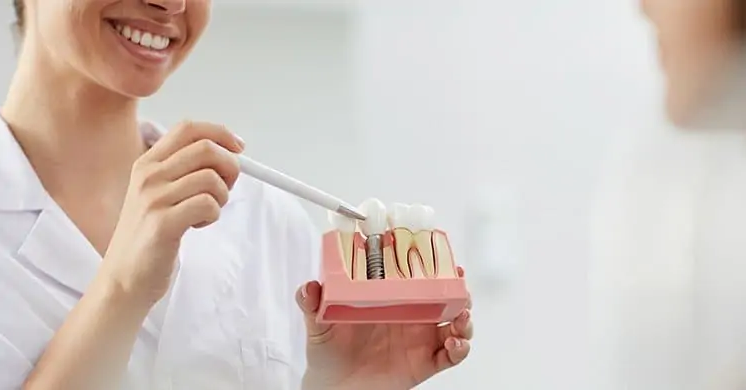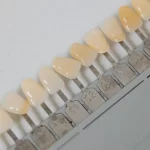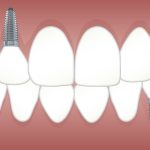What are dental implants?
This implant is a form of a fixed denture. In most cases, it refers to replacing a real tooth root with a fake one, directly into the jaw. In this way, any lost tooth can be replaced.
Crowns, bridges, or removable dentures are anchored on the implant. It takes on the role of a natural tooth root. A teeth implant, therefore, replaces both individual and several or even all-natural teeth.
Dental implants can be made of two different materials:
- Titanium
- Ceramics
Titanium is the most commonly used material. It has excellent biocompatibility and is accepted like the body’s own tissue. Ceramic implants are also available, but these are not as common as titanium-based implants.
Types of dental implants
The two-part implant system consists of an implant body — this is inserted into the jawbone — and the so-called abutment, the visible structural part on which the dentist places the denture. With the one-piece implant system, the abutment is incorporated directly into the implant body. The different types of implants differ in length.
The following types of implants are available:
- Standard dental implants: The classics of implantology. They are eight to fourteen millimeters long.
- Short dental implants: Their short length is usually between six and eight millimeters. They can be used when the jawbone is severely degraded.
- Orthodontic implants / TAD: These implants are mostly used in orthodontics and are used to correct crooked teeth.
- Disk implants / BOI implants: This type of implant differs significantly from conventional dental implants. Its base is a circular platform that is inserted into the bone of the jaw.
How does the treatment with an implant work?
An appointment with the dentist is all that is required for the insertion of the dental implants unless the dentist has to remove the defective tooth first. The next day and a few weeks after planting, the progress of the healing process should be checked again in the dental practice.
First step: correct medical history
X-rays and slices are taken in advance.
Basically, every patient is thoroughly examined and then the effort is estimated, and carious teeth or gingivitis treated. Any existing findings are taken care of before the implantology treatment so that the treatment with dental implants is crowned with success in the long term.
Before the implant is inserted, your dentist will also examine whether or in which area bone augmentation may have to be carried out before the implantation.
Second step: exposure of the bone
During the examination, the dentist determines whether the patient has a solid, firm bone structure. For example, a firm, strong and robust bone does not require any bone grafting. With some implant systems, direct implantation is also possible without an abutment. However, this is only possible in special exceptional cases and for simple implants on which removable dentures, i.e. prosthesis, are fixed. If a patient cannot have an abutment performed, such implants could be considered.
If fixed dentures, such as a crown or bridge, are to be fixed on it, the bone of the jaw is exposed.
Third step: the implant is inserted
After exposure, special drills are used to prepare the base for the implant (so-called implant bed) so that the implants can later be safely and firmly aligned.
Usually, a drilling template is used for this, which specifies the exact direction and the correct angle.
The dental implants can then be inserted precisely into the bone. This process is known as implant placement. The exact positioning is very important so that no nerves are injured, but also to ensure the correct fit of the denture or prosthesis.
Fourth step: healing of the implant
The healing process usually takes between two and three months for dental implants in the lower jaw and between four and six months for an implant in the upper jaw.
The difference in the healing process is due to the higher bone density in the lower jaw. Subsequently, the dental implant can then be provided with an individual restoration, for example, a crown or other dental prosthesis.
How long does the treatment of the dental implant take?
In most cases, it will take no more than about 60 to 90 minutes to complete. However, this always depends on the general conditions in the individual case. Each patient is to be considered individually, so the care is sometimes very different.
If the two-stage procedure is used on you, there is also a healing phase of 3-6 months.
Is an anesthetic necessary when placing the implant?
In most cases, the dentist places the implant in the jawbone under local anesthesia. In principle, however, it is up to you to decide whether you opt for general anesthesia or twilight sleep for implantology instead of local anesthesia. Depending on the state of health, the specialist decides which anesthesia is the most sensible in each case.
What are the risks for your teeth with an implant?
Since implantology is now a part of the quality repertoire of most dentists, the risks are manageable. But precisely because it is a surgery, complications can’t be ruled out.
For example, the gums can become inflamed: If the inflammation is advanced, this is referred to as peri-implantitis. The inflammation can spread to the jawbone and even cause bone loss.
Before the implantation, you should be informed about the risks by your dentist and a detailed diagnosis should be carried out.
The pros and cons of dental implants
Benefits of a Dental Implant
- Healthy teeth next to the implant need not be disturbed
- Grinding teeth will not result in an infection
- Stress on the bone prevents bone loss
- Aesthetic result> Increase in quality of life
Disadvantages of a Dental Implant
- The duration of the dental treatment is significantly longer thanks to the healing process
- Higher costs, since the health insurance companies usually do not cover the costs of dental implants








